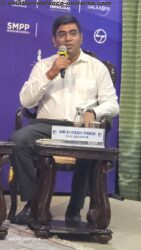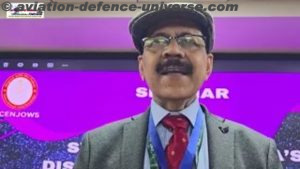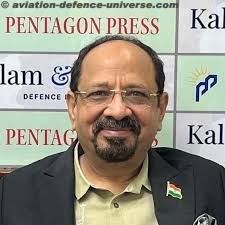
New Delhi. 10 February 2019. “India has set the tone for commercial aircraft manufacturing by tweaking its policies and has proposed a roadmap for creating a special purpose vehicle for developing regional transport aircraft. This complimented with schemes like Udan to promote regional air connectivity will go a long way in ensuring this,” said Sharadhi Babu, Chief Executive Officer, AXISCADES in an exclusive interview to Aviation & Defence Universe (ADU).
ADU. Please tell us about your company and the solutions you provide to your customers?
SB. AXISCADES is an end-to-end engineering services firm with interests across aerospace, defence, automotive, heavy engineering and medical technology with aerospace alone generating 40% of our overall revenues.
We have maintained our leadership positions across these sectors on the back of long-standing relationships with original equipment manufacturers and tier-I suppliers. This is further complimented by our 14 subsidiaries spread across the globe including India offering cutting edge technologies. In line with our rapidly expanding portfolio, we acquired Mistral Solutions in 2017 to enhance our competence in embedded electronics and improve our customer base in India.
As we evolve into a next-generation digital engineering services company, we will focus on extending service offerings to newer areas, forming alliances with innovative companies to multiply competencies, and ramping-up strategy in defence business to capitalise on the offset opportunity.
This transition is in line with the massive disruptions the engineering services industry is witnessing currently globally. The manufacturing industry is moving towards ‘Industry 4.0’, a scenario where technologies are witnessing rising use of automation and data exchange and customers are increasingly demanding integrated digital-led service offerings at right prices, while wanting long-term partners to step-up innovation and broaden offerings.
ADU. How does AXISCADES’ role in the Indian market differ from its other markets?
SB. India is one of the emerging markets for AXISCADES globally with special focus on the defence sector which constitutes a fifth of the company’s global revenues. This sector has become lucrative since the Union government’s vision of turning India into a defence manufacturing hub from being the largest importer of arms globally. This has opened up huge opportunities for companies like AXISCADES where we are developing cutting-edge robust solutions for the sector.
While our presence in core markets such as North America and Europe spans across verticals like aviation, automotive, defence, health tech etc., our focus is to grow business across these verticals here in India. We see huge opportunities in the aviation sector in India which is expected to boast of 2,359 commercial aircrafts by March 2040, as per KPMG and industry body Federation of Indian Chambers of Commerce and Industry. Similarly, the automotive sector which is the fourth largest in the world and the highest spender on ER&D is growing at rapid pace of nearly 15% year-on-year, becoming attractive for engineering services companies.
ADU. According to reports, India is set to become the third largest aviation market by 2025. What are the growth opportunities in aviation do you see in India?
SB. India is set to become the third largest aviation market by 2020 with over 2,000 aircrafts and the air passenger traffic touching 1.1 billion by 2040. This, coupled with the announcement of Defence Procurement Procedure in 2016, has ushered in reforms like automatic approval for Foreign Direct Investment (FDI) up to 49% and the Strategic Partnership Policy to create and nurture private defence capabilities in the country. This will set the tone for creation of aerospace manufacturing ecosystem in the country.
While commercial aircraft manufacturing is yet to set off in the country, it is already emerging as a strong player in the maintenance and repair operations industry with growing aerospace industry in the country. Reports expect the market for MRO to be estimated around $700-900 million in 2018 and the market is likely to hit $1.2 billion by 2020, spelling out huge opportunities for ER&D players like AXISCADES. We see huge opportunities in product lifecycle management and after sales product support where we are one of the most preferred partners of OEMs. From Engineering custom application development and maintenance and product lifecycle system implementation to structural repair engineering and life extension of aircraft structures, we offer a gamut of services to usher in the next level of transformation in the Indian Aviation Industry.
ADU. What is the outlook for the aerospace manufacturing industry, globally and in India? What are the factors you see that drive demand in this industry? Is India taking steps to promote commercial aircraft manufacturing in India?
SB. The Global Commercial Aircraft Manufacturing industry has grown by 4.3% to reach revenue of $840 billion in 2018 as per industry reports. Manufacturers today are ramping up their production capabilities to cater to the growing aircraft demand across the world. According to Deloitte, more than 1,600 aircrafts are expected to have been added to the global fleet in 2018 and another 100 are to be included this year. This growth is majorly driven by heightened passenger travel demand and resurgence in global growth.
Interestingly, the market is undergoing a transformation where the demand for narrow-body aircrafts offering higher capabilities is robust while wide-bodied aircrafts are going to witness subdued demand due to a backlog and OEMs deferring upgrades. However, both global and Indian ER&D industry is expected to post growth on the back of aforementioned factors. Nasscom says the global aerospace ER&D spend in aviation is projected to grow to $25-28 billion by 2020 from $24 billion in 2013 while India’s Aerospace ER&D exports stood at $1 billion in FY2015, a 6 per cent share in India’s total ER&D exports.
India has set the tone for commercial aircraft manufacturing by tweaking its policies and has proposed a roadmap for creating a special purpose vehicle for developing regional transport aircraft. This complimented with schemes like Udan to promote regional air connectivity will go a long way in ensuring this.
ADU. The 11th edition of Aero show is expected to see the biggest convergence of aircraft manufacturers. What are your expectations from it?
SB. The Aero Show 2019 is going to witness the convergence of Indian and global aircraft manufacturers and solution providers that will provide a platform to showcase the best in aviation technologies and set the tone for new trends unfolding in the industry. Having been organized since 1996, the exhibition has come a long way in shaping the current aviation ecosystem and we are glad to be a part of this prestigious exhibition.





































































































































